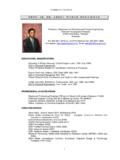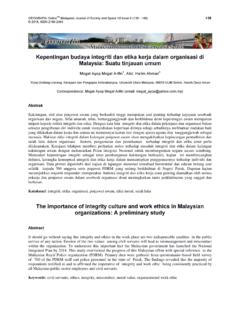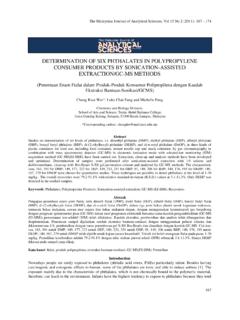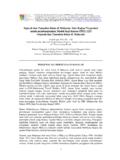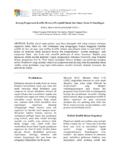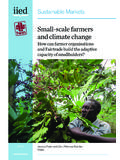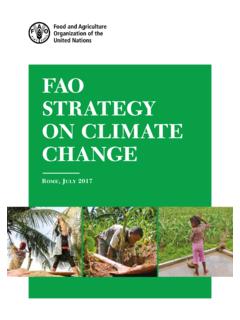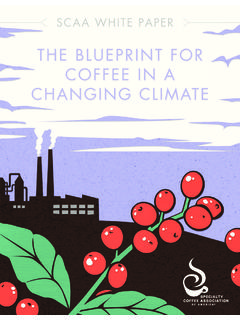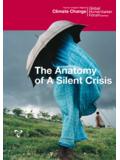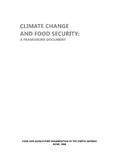Transcription of Consequences of climate change for European …
1 European Journal of Agronomy 16 (2002) 239 262 ReviewConsequences of climate change for European agriculturalproductivity, land use and policyJ rgen E. Olesena,*, Marco BindibaDepartment of Crop Physiology and Soil Science,Danish Institute of agricultural Sciences, ,DK-8830 Tjele,DenmarkbDepartment of Agronomy and land Management,Uni ersity of Florence, delle Cascine18,50144 Firenze,ItalyReceived 1 August 2001; received in revised form 8 January 2002; accepted 20 January 2002 AbstractThis paper reviews the knowledge on effects of climate change on agricultural productivity in Europe and theconsequences for policy and research. Warming is expected to lead to a northward expansion of suitable croppingareas and a reduction of the growing period of determinate crops ( cereals), but an increase for indeterminatecrops ( root crops). Increasing atmospheric CO2concentrations will directly enhance plant productivity and alsoincrease resource use northern areas climate change may produce positive effects on agriculture through introduction of new cropspecies and varieties, higher crop production and expansion of suitable areas for crop cultivation.
2 Disadvantages maybe an increase in the need for plant protection, the risk of nutrient leaching and the turnover of soil organic southern areas the disadvantages will predominate. The possible increase in water shortage and extreme weatherevents may cause lower harvestable yields, higher yield variability and a reduction in suitable areas for traditionalcrops. These effects may reinforce the current trends of intensification of agriculture in northern and western Europeand extensification in the Mediterranean and southeastern parts of will have to support the adaptation of European agriculture to climate change by encouraging the flexibilityof land use, crop production, farming systems etc. In doing so, it is necessary to consider the multifunctional role ofagriculture, and to strike a variable balance between economic, environmental and social functions in differentEuropean regions. Policy will also need to be concerned with agricultural strategies to mitigate climate changethrough a reduction in emissions of methane and nitrous oxide, an increase in carbon sequestration in agriculturalsoils and the growing of energy crops to substitute fossil energy use.
3 The policies to support adaptation andmitigation to climate change will need to be linked closely to the development of agri-environmental schemes in theEuropean Union Common agricultural will have further to deal with the effect on secondary factors of agricultural production, on the qualityof crop and animal production, of changes in frequency of isolated and extreme weather events on agriculturalproduction, and the interaction with the surrounding natural ecosystems. There is also a need to study combinedeffects of adaptation and mitigation strategies, and include assessments of the Consequences on current efforts * Corresponding author. Tel.:+45-89991659; fax:+ Olesen).1161-0301/02/$ - see front matter 2002 Elsevier Science All rights : S1161-0301(02) , (2002) 239 262240agricultural policy to develop a sustainable agriculture that also preserves environmental and social values in the ruralsociety.
4 2002 Elsevier Science All rights :Global warming; climate change ; Crops; Livestock; Policy; Impact assessment; Adaptation; Mitigation; Europeanagriculture1. IntroductionAgriculture is situated at the interface betweenecosystems and society. As such agriculture isaffected by the changes in the global environmen-tal conditions, but agriculture also contributes toabout 20% of the emissions of greenhouse gases,notably methane and nitrous oxide (Rosenzweigand Hillel, 2000). The agricultural ecosystemsvary from highly intensive farming systems suchas the arable cropping systems of western Europeto the low-input farming systems such as subsis-tence farming in sub-Saharan Africa. The highestemissions of greenhouse gases from agricultureare generally associated with the intensive farmingsystems (IPCC, 1997), whereas some of the lowinput farming systems currently located in mar-ginal areas may be most severely affected byclimate change (Reilly and Schimmelpfennig,1999; Kates, 2000).
5 The overall driving force in agriculture is theglobally increasing demand for food is primarily caused by a growing world pop-ulation with a high demand for food productionand a wealthier world population with a higherproportion of meat in the diet (Evans, 1998). Theresult is that agriculture globally exerts increasingpressure on the land and water resources of theearth, which often results in land degradation, erosion, salinisation and pollution (Kirch-mann and Thorvaldsson, 2000). climate change is expected to affect agriculturevery differently in different parts of the world(Parry et al., 1999). The resulting effects dependon current climatic and soil conditions, the direc-tion of change and the availability of resourcesand infrastructure to cope with change . There is alarge variation across the European continent inclimatic conditions, soils, land use, infrastructure,political and economic conditions (Bouma et al.)
6 ,1998; Rabbinge and van Diepen, 2000). Thesedifferences are expected also to greatly influencethe responsiveness to climatic change (Parry,2000).Most of Europe has experienced increases insurface air temperature during the 20th century,which amounts to C in annual mean temper-ature over the entire continent (Beniston and Tol,1998). Results of GCM model simulations indi-cate that large climatic changes may occur overthe European continent as a result of the likelyincrease in atmospheric concentrations of green-house gases caused by anthropogenic results of an analysis of a number of GCMsimulations indicate that annual temperaturesover Europe warm at a rate of between C decade 1(Parry, 2000). The greatest in-creases are expected over southern Europe andnorth-east Europe. The general pattern of futurechanges in annual precipitation over Europe is forwidespread increases in northern Europe (between+1 and+2 percent decade 1), rather smalldecreases over southern Europe (maximum 1percent decade 1) and small changes in aim of this paper is to review the currentknowledge on the impact of climate change onagriculture in Europe and to put this into thecontext of current agricultural policy.
7 The paperdiscusses the possible effects of climate change onEuropean agricultural policy as well as the inter-action between agriculture and other importantsectors of European European agricultureEurope is one of the world s largest and mostproductive suppliers of food andfibre (Table 1).The 15 countries of the European Union (EU)thus alone accounted for 10% of the global cerealproduction and 16% of global meat production , (2002) 239 262241 Table 1 Population, land area, agricultural area and annual production in the EU, the EU+12 and in Europe in per cent of total world sumsEU (%)EU+12 (%)Europe (%)World13 Population (million)17566626 land area (Mha)1304823173 agricultural area (Mha)44938101014208119 Cereal production (Gt)56 Pulses production (Gt)11121779 Oil crop production (Gt oil)1210371264821 Root and tuber production (Gt)433 Fruit production (Gt)121417911 Vegetable production (Gt)1562633234 Fibre crop production (Gt)223 Meat production (Gt)1620242227 Milk production (Gt)39562 Population data are based on FAO statistics from year 1995, and land use and production data are based on FAO statistics from1998.
8 The EU currently covers 15 countries, and 13 countries have applied for EU membership. The EU+12 covers current EUmember countries plus countries that have applied for membership, excluding in the EU accounts for only 2% ofthe total GDP, but accounts for of totalemployment. The vulnerability of the overalleconomy to changes that affect agriculture istherefore low, but locally effects may be Europe dairy and meat productionare major activities, which in combination withintensive arable farming systems result in highagricultural outputs in both EU and in Europe asa whole (Table 1). agricultural land use in thedifferent regions in Europe is shown in Table can be divided into a number of majoragricultural regions determined by both environ-mental and socio-economic factors (Fig. 1). Re-gions 1 to 5 in Fig. 1 are mainly characterised bymarket-oriented agriculture, which has been heav-ily influenced by the EU Common AgriculturalPolicy (CAP).
9 Agriculture in the northern region1 is limited by climatic and soil conditions andonly a small percentage of the land is cultivated(Table 2). Agriculture in large parts of region 2 isdominated by the wet conditions along the At-lantic coasts, and grasslands dominate this intensive arable and livestock farming isseen in region 3, which has small-scale, mixed orlarge-scale intensive farming systems. In themountainous region 5 both market-oriented agri-culture and transitional forms from extensivemixed farms to market-oriented farming 4 is characterised by the drier and warmerMediterranean climate , which has led to a diversepattern of agriculture. A market-oriented type ofagriculture with mainly crop cultivation, includingfruit trees, olive and grapes, predominates (Table2). Alternatively, in this region considerable areasof the traditional small-scale type of agriculturestill occur (Kostrowicki, 1991).
10 Fig. 1. Major agricultural regions in Europe (see Table 2 forregion names and characteristics). , (2002) 239 262242 Table 2 land use and population in different regions of Europe based on FAO statistics from 1998 Percent of agricultural areaRegionPopulationAgricultural areaCerealsPermanent cropsaPermanent pastureIrrigatedTotal (mill.)Rural (%)% of landMill. haArable1151925421. British Isles1734333717117523. North South eastern576137317327119618. statistics are from crops are crops that occupy land for many years, shrubs, fruit trees, nut trees and , (2002) 239 262243 Table 3 Development in wheat area and wheat yield (16% moisture content) in main European regionsWheat area (1000 ha)RegionWheat yield (Mg ha 1)1985 19891995 19991975 19791975 19791985 19891995 19991. British North South 32710 EasternData is based on FAO statistics. Numbers with different letters within a row in each category are significantly different at the 95%confidence 6 7 in Fig.


